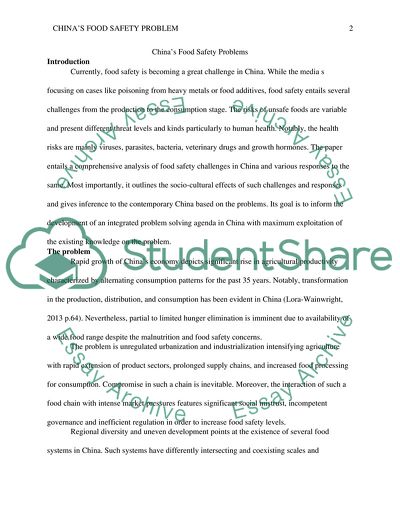Cite this document
(Chinas Food Safety Problems Case Study Example | Topics and Well Written Essays - 2000 words, n.d.)
Chinas Food Safety Problems Case Study Example | Topics and Well Written Essays - 2000 words. https://studentshare.org/anthropology/1874710-chinas-food-safety-problems-and-other-food-related-environmental-health-hazards-have-in-recent-years-received-growing-scholarly-attention-what-might-these-hazards-and-peoples-responses-to-them-tell-us-about-contemporary-chinese-society
Chinas Food Safety Problems Case Study Example | Topics and Well Written Essays - 2000 words. https://studentshare.org/anthropology/1874710-chinas-food-safety-problems-and-other-food-related-environmental-health-hazards-have-in-recent-years-received-growing-scholarly-attention-what-might-these-hazards-and-peoples-responses-to-them-tell-us-about-contemporary-chinese-society
(Chinas Food Safety Problems Case Study Example | Topics and Well Written Essays - 2000 Words)
Chinas Food Safety Problems Case Study Example | Topics and Well Written Essays - 2000 Words. https://studentshare.org/anthropology/1874710-chinas-food-safety-problems-and-other-food-related-environmental-health-hazards-have-in-recent-years-received-growing-scholarly-attention-what-might-these-hazards-and-peoples-responses-to-them-tell-us-about-contemporary-chinese-society.
Chinas Food Safety Problems Case Study Example | Topics and Well Written Essays - 2000 Words. https://studentshare.org/anthropology/1874710-chinas-food-safety-problems-and-other-food-related-environmental-health-hazards-have-in-recent-years-received-growing-scholarly-attention-what-might-these-hazards-and-peoples-responses-to-them-tell-us-about-contemporary-chinese-society.
“Chinas Food Safety Problems Case Study Example | Topics and Well Written Essays - 2000 Words”. https://studentshare.org/anthropology/1874710-chinas-food-safety-problems-and-other-food-related-environmental-health-hazards-have-in-recent-years-received-growing-scholarly-attention-what-might-these-hazards-and-peoples-responses-to-them-tell-us-about-contemporary-chinese-society.


